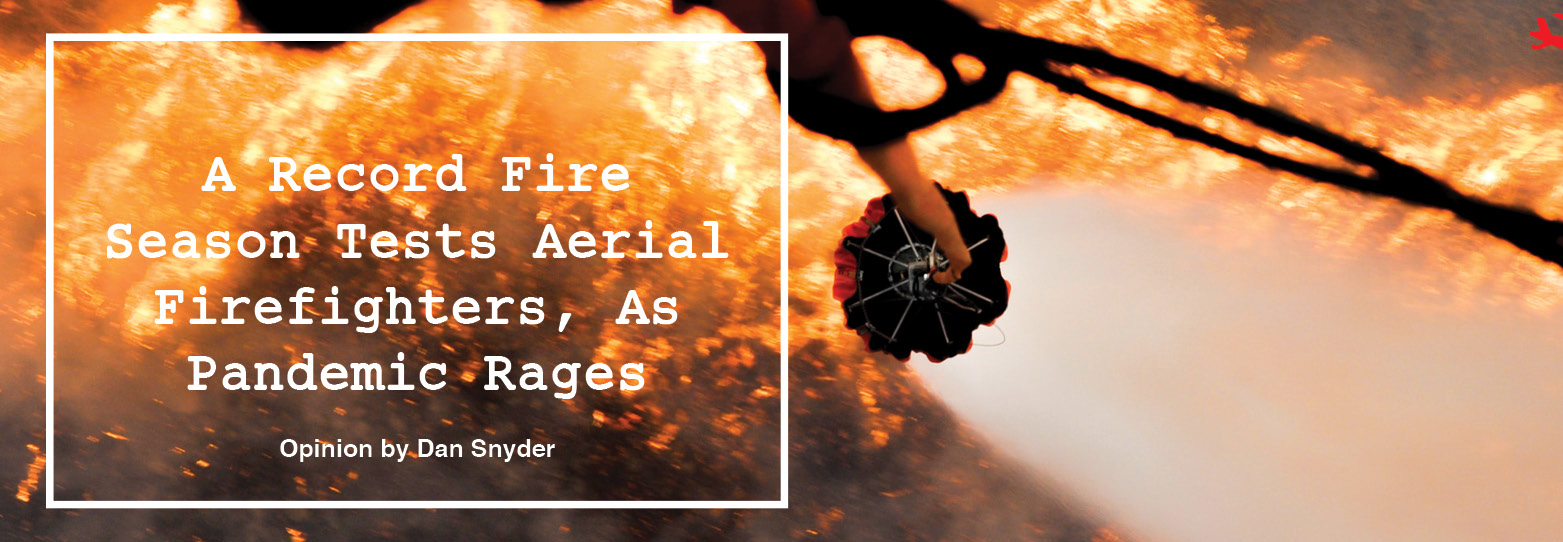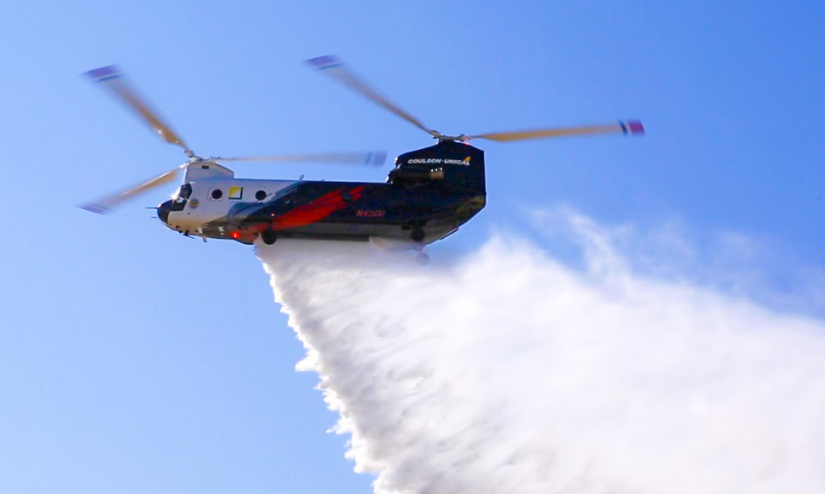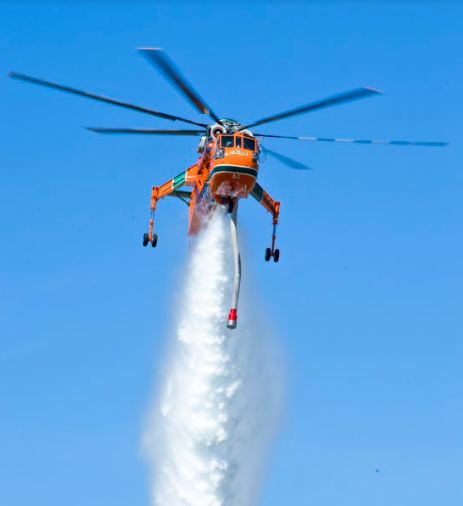|
Mar
15
2021
|
|
Posted 4 years 281 days ago ago by Admin
|
|

The aerial firefighting industry faced unprecedented challenges throughout 2020. For starters, it was a record year for wildfires, particularly in California, Arizona, New Mexico, and Colorado, as well as uncharacteristically active in Oregon.
At a glance, the numbers show a significant increase in wildland fire events over the previous year. According to year-to-date National Interagency Fire Center statistics as of 13 November 2020, 49,815 fires destroyed 8,750,197 acres. For the 2019 comparable period, 45,840 fires burned 5,418,234 acres. All indications are that dry conditions will persist, especially in the West, and fire seasons will get longer and more destructive, as the fuel load—the vegetation that will dry out in the summer—increases. Along with this, the trend toward residential development in the wildland/urban interface makes the fires that much more catastrophic—and more deadly.
The question then is: How well prepared are the helicopter and tanker operators to deal with this new normal? Fortunately, the industry is currently in a stabilized mode, and better positioned to meet the challenges of the predicted worsening fire seasons to come.
In that regard, the majority of the aerial firefighting industry has largely transitioned to more modern equipment. Vendors of aerial firefighting services, who have been operating large airtankers over the past five to six years, have settled upon their aircraft choice, and the tanking systems installed in those aircraft are better designed. Also, compared to legacy aircraft, the newer tankers offer faster airspeed, better and higher dispatch reliability, and increased retardant carrying capacity. Parts availability is higher because the OEMs who manufactured the aircraft are still in business and continue to support them. In 2020, approximately 40 air tankers were under U.S. Forest Service (USFS) contract, about double the number a decade ago.

We are also seeing considerable change on the helicopter side, as operators move toward a new generation of equipment for aerial firefighting. For example, more Type-1 helicopters—defined by the USFS as those that can carry 10 or more passengers, have a certified internal gross weight over 14,001 pounds, and are able to carry up to 700 gallons of water—are entering the fleets. This is because a lot of military surplus Sikorsky UH-60 Black Hawks and Boeing CH-47D Chinooks are becoming available to the civilian market at relatively cheap prices. Currently, there are 25 to 30 Type-1s in the aerial firefighting helicopter fleet now, about double the number of five years ago. In fact, for the helicopter operators engaged in aerial firefighting, the Type-1s have become the preferred helicopter type, as they transition away from aging, smaller Type-2 and Type-3 models—both types with 9 seats or less, and with respective certified internal gross weights of 7,000 to 14,000 pounds (Type 2), and under 7,000 pounds (Type 3); as well as tank capacities of 300 (Type 2) and 100 gallons (Type 3).
In tandem with fleet changes and a record fire season, the industry had the additional challenge of dealing with a disruptive global pandemic. COVID-19, coupled with an extraordinary number of fires, had the greatest impact on the industry this year and presented a new set of issues. For instance, transportation of personnel around the country became problematic as some locations normally served by multiple daily commercial flights were cut back or eliminated. In conjunction, lodging for fire crews went off-line in many cases.
COVID-19 also caused a major philosophical change by firefighting agencies with respect to the positioning of ground firefighters and aircrews. They moved away from large fire camps with high personnel concentrations toward deploying smaller groups spread out over more locations. The result was that more aircraft were deployed earlier than in the past 10 years. For example, during 2020, approximately 36 helicopters were put on 90-day ‘surge’ contracts by the USFS. The surge fleet, which included Type 1 and Type 2 helicopters, was added to those already under contract. With the additional helicopters in the field for initial attack, there was less need to maintain large fire camps, thus minimizing the risk of spreading the virus.
There were a lot of positives that came out of this. Aerial assets were based in closer proximity to fires and there was less need to move people around. It remains to be seen if this tactical shift in aircraft and aircrew deployments will prevail post-COVID-19. But, the industry and firefighting agencies did a wonderful job in the face of the coronavirus in tandem with the tremendous increase in fire activity.
Still, further challenges must be met. There is a threat to the long-term financial stability of the aerial firefighting industry, as the USFS has essentially switched back to a contract award system based on the cheapest price, as opposed to the best value. With cut-backs in available funding, vendors lose some of the safety net within their organization as they become leaner by necessity.
One of the components of this trend has been a transition to more call-when-needed (CWN) contracts, and away from exclusive-use (EU) contracts. According to USFS statistics, in both 2019 and 2020, there were a total of 13 large airtankers on EU, and 22 on CWN. But far more helicopters—approximately 400—were under CWN in 2020, in contrast to 150 in 2019. For both years, 104 helicopters were on EU.

There is no question that EU contracts, which guarantee an agreed-upon pay rate over a specific contract period, provide better maintenance stability for vendors and higher standards and quality of operation. However, CWN contracts have a level of risk that is unique to the aerial firefighting industry, and could hurt us about five to 10 years down the road. Simply put, CWN contracts are a big gamble. It’s true that more money is earned under CWN contracts when the operator is working, but during down times no money is earned. As a result, the CWN contracting trend can have a negative impact on our country’s aerial firefighting capability because it will effectively drive operators toward other kinds of work such as construction or power-line patrol.
The CWN trend has driven some operators away from firefighting altogether, which means a loss of assets to the fire agencies. Where possible, some are even shifting their targeted customer base outside of the U.S. I know of one helicopter operator for which the U.S. historically accounted for about 60 percent of its annual business. Over the past year, the company has had to focus more on international customers, which now account for 75 percent of its yearly business, thanks to the reduction of the USFS budget. For those CWN-dependent operators who do not have similar opportunities, a less active fire season, such as the one we had in 2019, could put them out of business.
At the same, the industry should be aware of considerations by state governments to establish their own aerial firefighting capabilities, much as California did years ago. The Colorado Division Of Fire Prevention and Control confirmed that it is looking at moving in the direction of agency-owned helicopters in the future, although no decisions have been made to acquire helicopters at this time. Other states, specifically in the western U.S., are giving this consideration as well.
Another concern is the direction the USFS may want to go with helicopter fleet modernization. On 15 October 2020, the agency issued a Request For Information (RFI), titled “National Exclusive-Use Helicopter Modernization,” (Special Notice Number: SN-2021-01). Specifically addressing the Type- 2 EU contracted helicopter fleet, the RFI’s purpose is to gather research concerning the daily cost of bringing a next-generation of helicopters on-stream, which would offer greater speed, improved crashworthiness, higher reliability, payload, and multi-mission capability under EU contracts ranging from 120-240 days.
The problem is, as it stands right now, the agency has not indicated their long-term requirements, which the operators need to know in order to prepare. Before the industry spends money on newer helicopters, it will need to get a commitment from the USFS in the form of long-term EU contracts.
I also believe we need to have a cultural change at the USFS, in terms of their expectations as to the performance of a modern helicopter in a utility role. They will have to look at lessons learned over the years, to see where we came from and where we are today.
Dan Snyder is a senior VP with Neptune Aviation Services